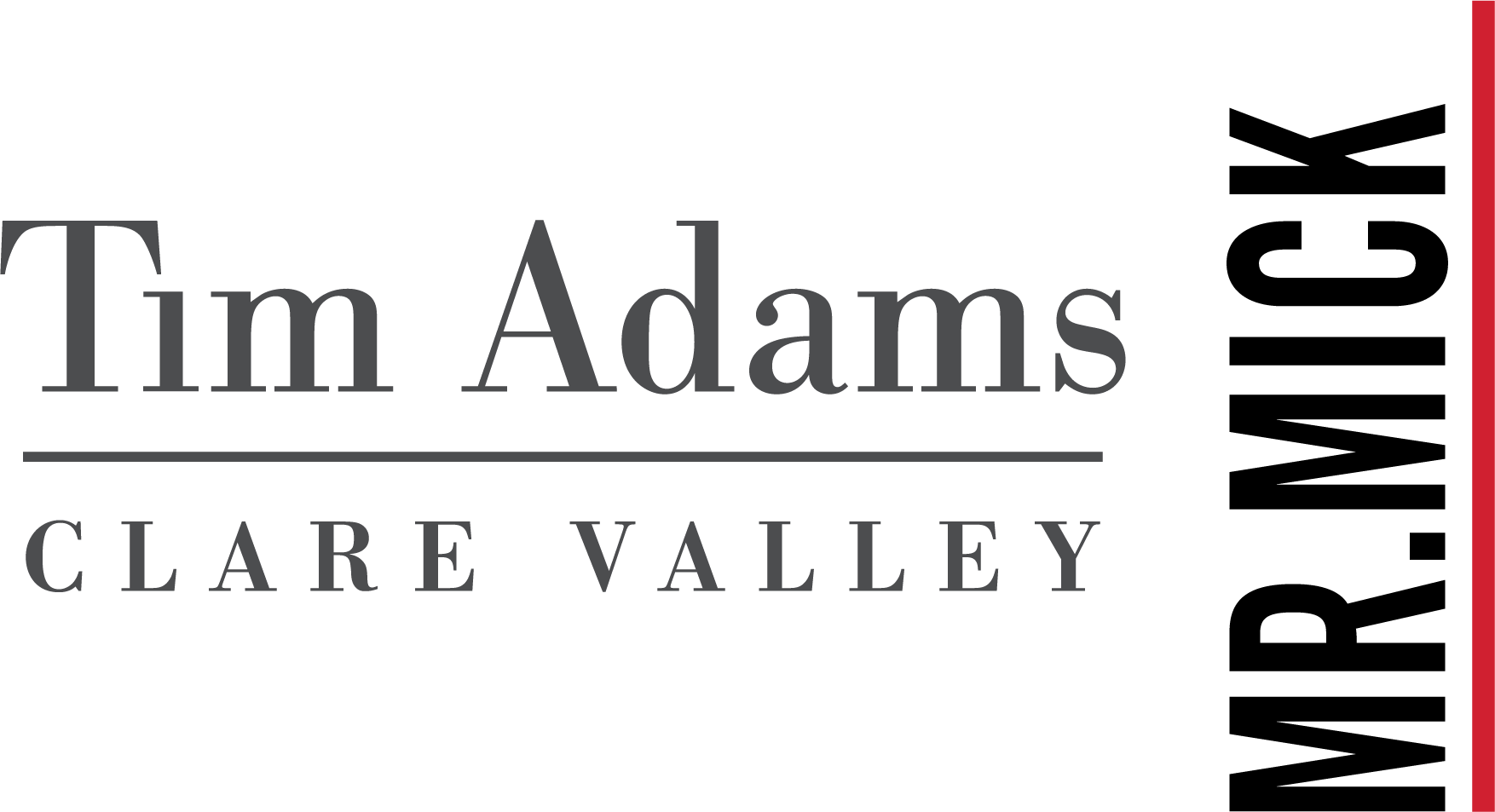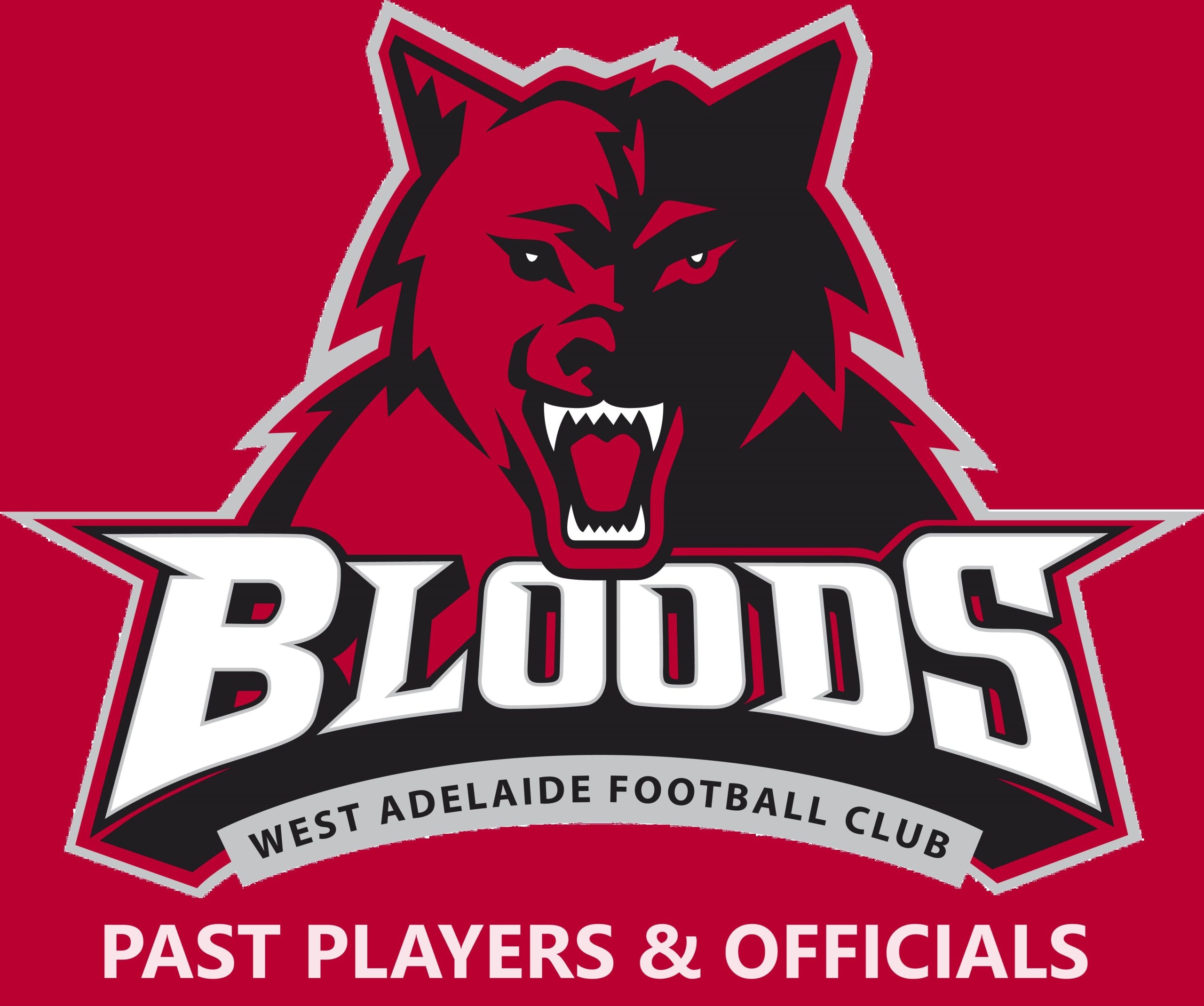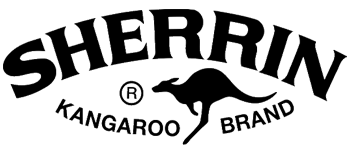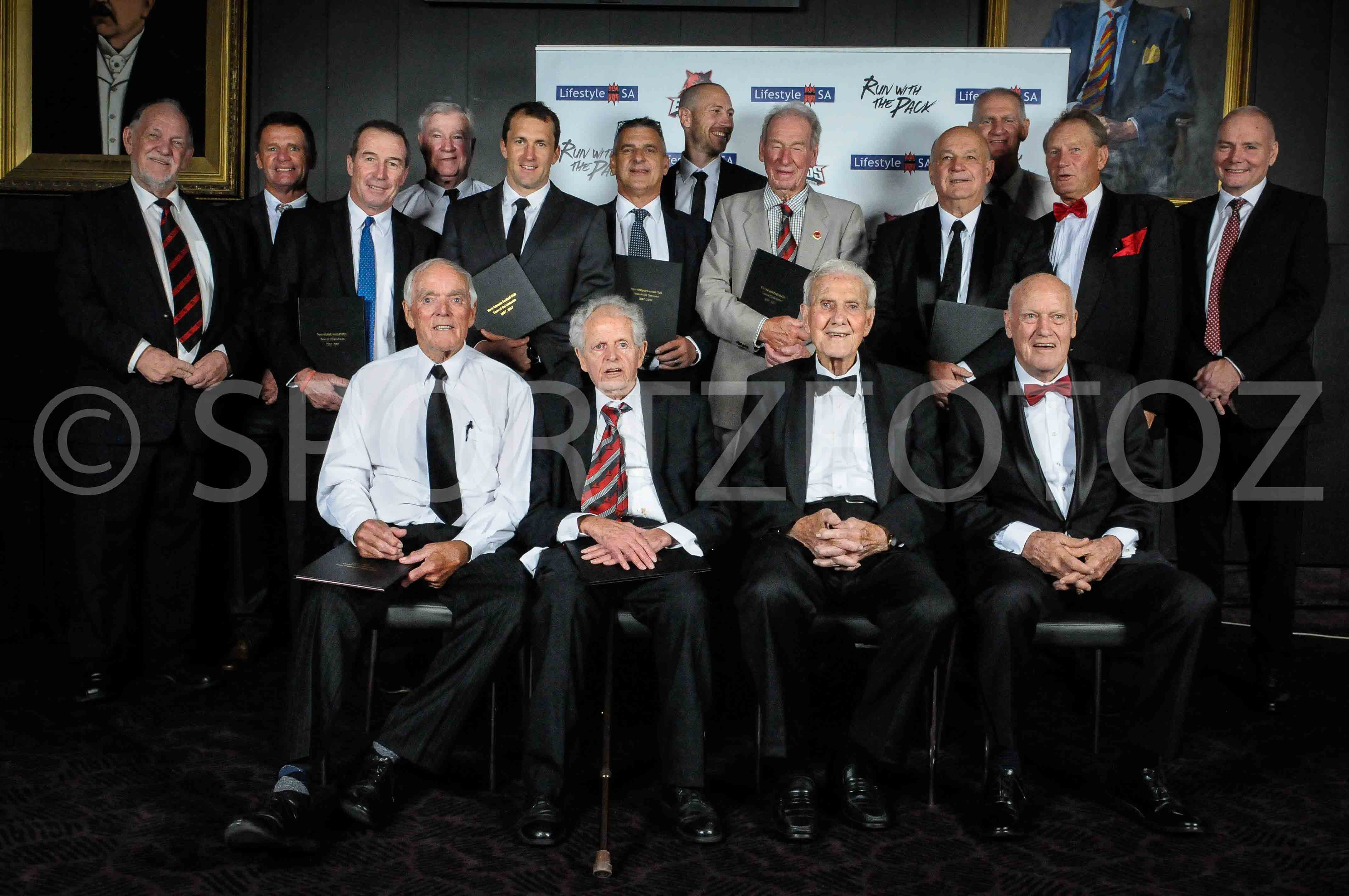
Team of the Centuries
The Process
BACKGROUND
In 2017 the South Australian National Football League, which is the oldest codified football competition in Australia, celebrated 140 years of operation while the West Adelaide Football Club celebrated its 125th birthday, being established some time in 1892 before joining the SANFL in 1897. 2017 was also the anniversary of our 1927 and 1947 premierships.
To celebrate these milestones, the WAFC waited for the completion of our 125th year of competition and selected a Team of the Centuries.
CRITERIA
At the time of selection their were 1405 known players to represent West Adelaide in an official ‘Home and Away’ season game, a criterion was set such that a player had to have played 50 league games for our club. This left a pool of 280 players.
The 50 game qualification ruled out West Adelaide champions who dominated the VFL/AFL/WAFL like Tony Modra (34), Shaun Rehn (20), Tyson Edwards (42), and Brownlow medal winners Patrick Dangerfield (4), Adam Cooney (12) and Mark Ricciuto (26).*
To narrow the list of 280 players to just 50, players had to have played more games for West Adelaide than for another SANFL club, which ruled out champions like Tom Leahy, and Mark and Fos Williams to name but a few. Players were also to be selected in their normal playing
positions.
Candidates from across all eras were then narrowed down to a list of 50, with all their stats and history made available. The voting panel then independently selected their own teams which were brought back to the full committee for tallying and comparison.
22 players were then selected along with four interchanges and four versatile emergencies. This process was arduous with some champions being left out. Eventually a consensus was reached, sometimes based on character, and when two players seemed identical statistically.
*Number in brackets indicated games played for WAFC
EXPLANATION OF THE ERA’S
The West Adelaide Team of the Centuries is unique in that it spans three centuries (1897-2017). Players were split into 20-year eras and evaluated by their feats in accordance with the era in which they played. Each era had its pros and cons with regards to evaluating player service, as you will see below.
Every era has had challenges but West Adelaide, in each of these years since 1897, has produced champion players and teams. At the time of selection Neil Kerley said, “It’s only a great team if champion players miss out.” and this is certainly the case with the side selected.
TOC ERA 1: 1897 – 1916
In the first era of league football our beloved club won four premierships (1897-1916). The Home and Away season was generally only 12 rounds in length compared to modern times where often 22 minor rounds were contested, followed by finals. Also in the 1980s, an additional 5 night series games inflated player game figures. This meant that comparing players based on games played was unfair.
TOC ERA 2: 1917 – 1936
In era 2 World War 1 interrupted player careers when the SANFL suspended the competition from 1916-1918. Glenelg joined the SANFL as a league club in 1921 but still only 14 minor round games were programmed.
TOC ERA 3: 1937 – 1956
Era 3 was interrupted by World War 2, with a Patriotic Competition introduced seeing West and Glenelg join together. Many players joined the forces and again careers were interrupted, and this had to be taken into consideration by panellists. Central District and Woodville’s admission as league teams also changed the demographics of zones, with Woodville having a huge impact on West Adelaide and West Torrens in terms of junior development.
TOC ERA 4: 1957 – 1976
Era 4 was a golden era in South Australian football. Night games were introduced, as was the Australian Club Championships and Champions of Australia series. Some players managed upwards of 30 games in a season. National Service and the Vietnam War also interfered with playing careers.
TOC ERA 5: 1977 – 1996
Era 5 saw Football Park come into its prime. Port Adelaide’s betrayal of its SANFL brotherhood saw the fabric of football in South Australia change with the formation of the Adelaide Crows and later the Port Adelaide Power. State football was slowly being killed off and the days of Carnivals where players could often rack up as many as five state appearances in a year dwindled. In the present SANFL era, one state game a year is played and that is under threat with the VFL withdrawing from such contests for the foreseeable future.
TOC ERA 6: 1997 – 2017
Era 6 saw the AFL become a professional league. By 1996, the SANFL owned two AFL licences (Adelaide Crows and Port Adelaide). These licences were eventually sold to the two AFL clubs giving them independence from the SANFL. Further historical changes came when the SANFL Magpies and Port Adelaide “Power” merged their separate entities when they initiated the ‘One Club’ campaign. Prior to this, both Port Adelaide clubs had separate administration sites, their own annual report and balance sheets, unique assets and operated a Port Community Club that meted out a pro-rata share of Alberton bar takings between the two entities, as compensation for the Magpies having to leave Alberton and, at one stage, train at Ethelton Oval. This ‘one club’ merge removed the stand-alone Magpies from the league as shareholders and saw the Magpies relinquish its junior and country zones. In 2014, the
Magpies officially changed its heritage again by assuming similar conditions to the Crows’ SANFL side, having all its AFL players play under the Magpies Jumper.
THE SELECTION PANEL
The panel consisted of a chairman, the club historian and 7 voting members. Each member had a unique perspective on our club’s history as can be seen below.
BARTON, GRAEME
The vice-president of the WAFC is the main reason this wonderful project was established and completed. Graeme has served the West Adelaide Football Club in an official capacity since 2008 and been a board member of both the Football Club and Westonians, serving the club in a variety of roles. Graeme also established the WAFC History Group in 2014 and is an active member of the Hall of Fame committee. He wrote the criteria for the Team of the Centuries selection panel and was a non-voting member of the group, but chaired and directed each meeting.
BESWICK, MARK
Son of Kevin – the former Port player and West Adelaide Vice-Captain and Captain – Mark became the club’s first official historian, appointed by then General Manager Doug Thomas in 2004 and has served in this capacity since. He created the club war honour boards, fixed the life members’ board and listed in order of debut all West Adelaide league players. In 2014 he became a member of the Board and was also named the SANFL Official Historian in 2015. Mark wrote the profiles on all the candidates for the Team of the Centuries and for the Hall of Fame candidates since its inception, as well as authoring this publication. He was a non-voting member of the panel who provided commentary and insights on players in each of the meetings.
FAEHSE, BRIAN
The eldest member of the panel at age 93, Brian Faehse (after whom the club grandstand is named) debuted for the composite West-Glenelg side in 1944. His unique playing knowledge of players in this era helped the panel understand more about champions in this era and refined the panel’s views on various candidates. Brian’s assessments were invaluable to the panel and his contribution and memory of events was second to none as a voting member of the panel.
FIELKE, GRANTLEY
Yet another WAFC Hall of Fame Club Legend and now giving his name to a medal for club champions, Grant has played the most games for West Adelaide. He regularly reminded panellists that a great football team needed players with integrity and lived WAFC values as well as having outstanding football ability. His perspectives helped panellists break deadlocks over players who were vying for the same position and his vast experience and football knowledge of players over three decades, as well as his VFL/AFL experiences, proved invaluable. Grant was also a strong advocate for players in the early eras of football bringing balance to the team, as a voting member of the panel.
HARRADINE, LEE
Lee has served West Adelaide in almost every official capacity for 29 years: Team Manager, Head Trainer, Recruiting Committee, Accountant and now Club President. Lee’s knowledge of players past and present made his input invaluable. Lee is a life member of the club along with his brother Noel and, of course, grandfather Vin “Stud” Harradine who served as timekeeper for 48 years, only to have his service interrupted by World War 2. Lee’s input regarding players and their character off field was also invaluable in group discussions as a voting member of the panel.
KERLEY, NEIL
A WAFC Hall of Fame Club Legend, multi-capped state player and one of the most famous football names in South Australian football, Neil’s insights as both Captain of the club and coach over many eras helped focus the panel in many debates on players and their roles and positions for this team. Neil states to this day that the greatest team he coached was the 1983 side, with many players missing selection by the smallest of margins. Neil’s input and ability to take on and discern information about players and differing eras played a significant role throughout the process as one of the voting members
on the panel.
LOVEDAY, ROBERT “BOB”
One of the club’s longest serving captains in a difficult era for the Bloods, Bob’s understanding of the playing group of his time was insightful, particularly having served as coach, playing up forward and of course down back. As a voting member of the panel, his assessment of players and especially their ability not only to dominate key positions, but have the durability to be versatile in other positions helped enormously with our problem of choosing a balanced interchange and list of emergencies.
THOMAS, DOUG
Another WAFC Hall of Fame Legend, Doug’s involvement both as player, coach and administrator and recruiter of players, spanning an official club involvement from 1951-2006, allowed the panel to consider players who may have otherwise been overlooked at first glance. Doug was a voting member of the panel and his experience made his contributions invaluable during many robust discussions on players for the final make-up of the team.
TIDSWELL, DAVID
Very few people in football would have an awareness of players in so many football competitions around Australia. A life member and key recruiting officer of the club and foundation member of the WAFC Hall of Fame, David’s breadth of knowledge of early footballers up to those in the current era was unparalleled as a voting member of this panel. David’s ability to fight for players across all eras of football brought about a great balance of representatives over the 3 centuries of the club’s existence and his input was invaluable and of great guidance to all the panel members.
The Team
The West Adelaide Football Club are proud to present the team selection for the WAFC Team of the Centuries.
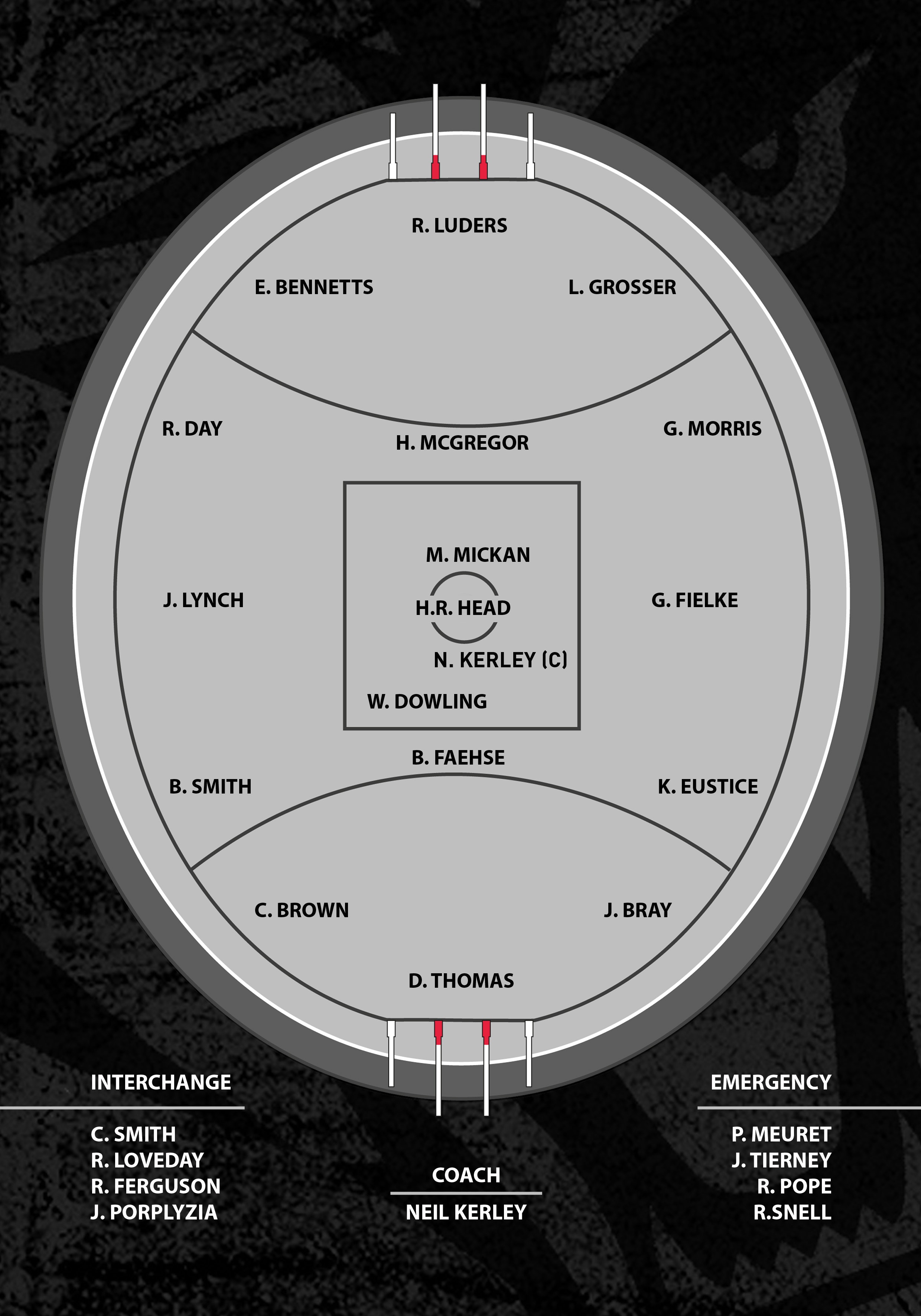
Souvenirs
Jamie Osbourne
Jamie was commissioned by the West Adelaide Football Club to create the “WAFC Team of the Centuries” official souvenir artwork. Jamie was sourced because of his extensive talent, having created similar pieces for Norwood, Port Adelaide and Central District Football Club.
Examples of Jamie’s art works can be found at his website – http://jamieosborne.com.au/
The original artwork has been retained by the Club and will be exhibited permanently at Richmond Oval for the public to view.
2 full size reproductions were made, one which will be kept by the club and displayed in the players area, and the other which was successfully auctioned by the Club during the Team of the Centuries dinner on Friday the 20th of April.
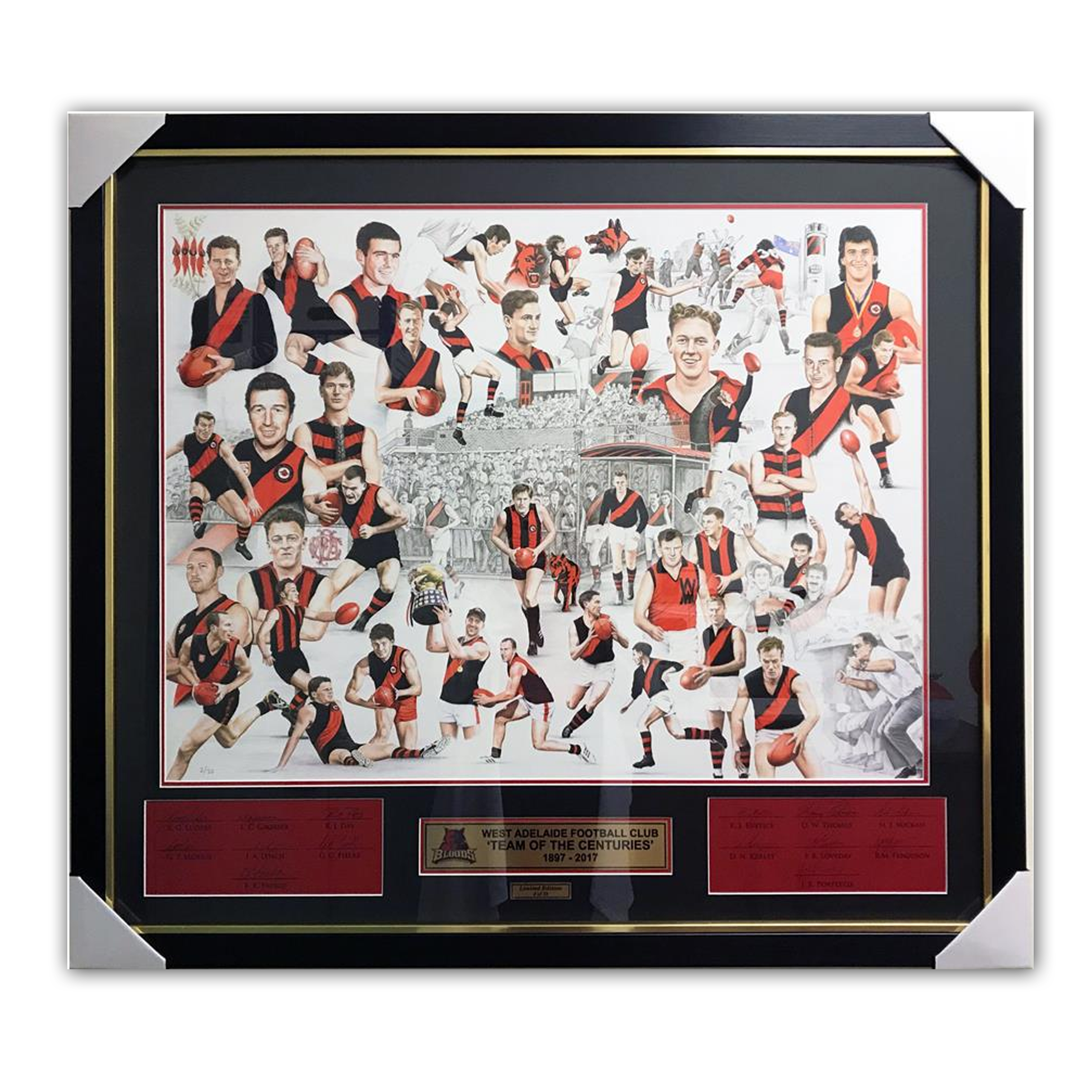
Large Frame
22 Framed Limited Edition Print were made available for purchase
Each print is signed by 14 living members of the team
Print size 84x59cm
You will be contacted by the club to organise print number, and framing after purchase
$800
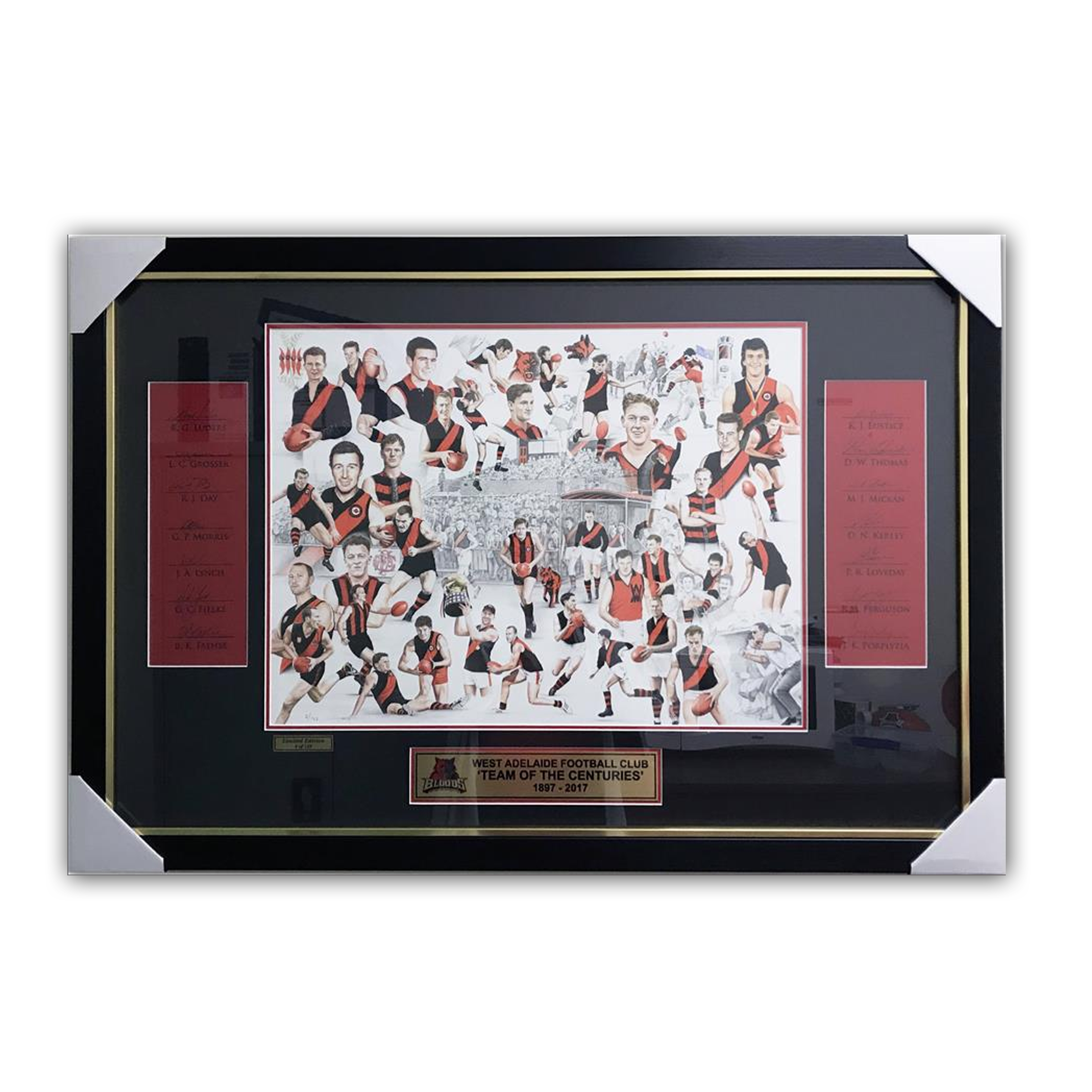
Small Frame
122 Framed Limited Edition Print were made available for purchase
Each print is signed by 14 living members of the team
Print size 59x42cm
You will be contacted by the club to organise print number, and framing after purchase
$400

Official Team of the Centuries Souvenir Book
Includes player profiles for all 22 players and 4 emergency players
Includes statistics on the top 50 selected squad
$30






